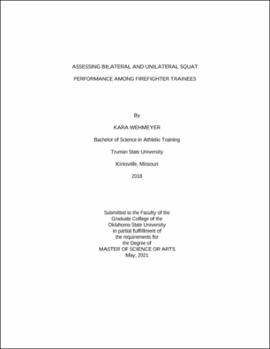| dc.contributor.advisor | Dawes, Jay | |
| dc.contributor.author | Wehmeyer, Kara | |
| dc.date.accessioned | 2021-09-24T13:58:18Z | |
| dc.date.available | 2021-09-24T13:58:18Z | |
| dc.date.issued | 2021-05 | |
| dc.identifier.uri | https://hdl.handle.net/11244/330954 | |
| dc.description.abstract | Firefighting is a physical demanding job which requires firefighters to operate in potentially dangerous atmospheres. The added weight and movement restriction of the firefighter's protective equipment may cause movement compensations, increasing the firefighter's risk of musculoskeletal injury. Breaking down a firefighter's movement pattern may give indication of any movement dysfunctions that may predispose the firefighter to musculoskeletal injury. Movement screens assess the interaction of the kinetic chain and may help identify compensatory movement patterns. A common denominator of movement screens is a variation of the squat, which allows clinicians to observe the whole lower body kinetic chain in one exercise. The purpose of this study was to determine if significant relationships exist between anthropometric variables, range of motion and squat depth in the body weight and unilateral squat. Bodyweight and unilateral squat data from 31 male firefighter trainees were utilized for this analysis. Range of motion for the ankle, knee, hip, and trunk was measured using a markerless motion analysis system. Squat depth was recorded in inches and calculated as a percentage of the lower body length, based on the distance from iliac crest to the ground. A Pearson's product correlation was used to examine relationships among the lower body functional tests, height, body mass, and joint range of motion. Significant negative correlations were found between body mass and left (r=-.481; p<.01) and right (r=-.507; p<.01) knee flexion as well as squat depth for the body weight (r=-.475; p<.01) and left (r=-.482; p<.01) and right (r=-.408; p<.01) unilateral squat. A large correlation was found between knee flexion and squat depth for the bodyweight and unilateral squat. No significant correlations were found with ankle, hip, or trunk flexion and squat depth. Likewise, there were no significant differences found between the left and right ankle, knee, or hip range of motion in this group. It is expected that range of motion may decrease later in the firefighters' career due to age and potential injuries. Routine movement analysis screens should be performed throughout the firefighter's occupational life span to identify movement dysfunctions and mitigate injury. | |
| dc.format | application/pdf | |
| dc.language | en_US | |
| dc.rights | Copyright is held by the author who has granted the Oklahoma State University Library the non-exclusive right to share this material in its institutional repository. Contact Digital Library Services at lib-dls@okstate.edu or 405-744-9161 for the permission policy on the use, reproduction or distribution of this material. | |
| dc.title | Assessing bilateral and unilateral squat performance among firefighter trainees | |
| dc.contributor.committeeMember | Volberding, Jennifer | |
| dc.contributor.committeeMember | Trevino, Michael | |
| osu.filename | Wehmeyer_okstate_0664M_17166.pdf | |
| osu.accesstype | Open Access | |
| dc.type.genre | Thesis | |
| dc.type.material | Text | |
| thesis.degree.discipline | Health and Human Performance | |
| thesis.degree.grantor | Oklahoma State University | |
